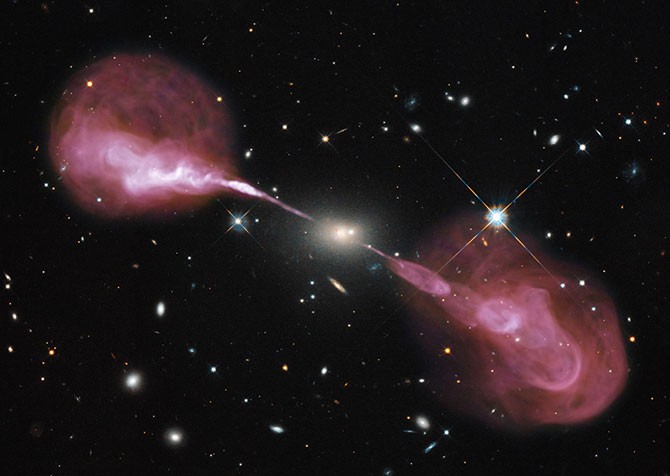A team of international astronomers has made an unprecedented discovery of a galaxy that has undergone a significant classification shift due to its core activity. Previously known as a radio galaxy, PBC J2333.9-2343 is now a giant radio galaxy that is 4 million light-years across with a blazar in its center.

Blazar in PBC J2333.9-2343
A blazar is an active galactic nucleus (AGN) that emits high-energy radiation, considered one of the most powerful phenomena in the universe.
The blazar in PBC J2333.9-2343 has a relativistic jet directed towards the observer, moving at speeds close to the speed of light, emitting radiation across the entire electromagnetic spectrum.
The researchers found that the jet changed its direction drastically by up to 90 degrees, from being perpendicular to Earth's line of sight to pointing directly toward us.
With the jet pointing towards us, the emission from the galaxy is strongly enhanced, driving high-intensity flares stronger than those coming from other radio galaxies.
This change in direction led to the reclassification of the galaxy as a radio galaxy with a blazar at its center. Typically, a galaxy's classification is based on the orientation of its jets.
When a galaxy has two jets pointing in the same direction, it is referred to as a radio galaxy; however, if one of the jets is pointing in our direction, the galaxy's AGN is referred to as a blazar.
The astronomers observed PBC J2333.9-2343 across a wide range of the electromagnetic spectrum, using radio, optical, infrared, x-ray, ultraviolet, and gamma-ray telescopes.
They compared the galaxy's properties with large samples of blazars and non-blazar galaxies provided by the ALeRCE project in Chile with data from the Zwicky Transient Facility and the Asteroid Terrestrial-impact Last Alert System.
Read Also: Astronomers Discover the Largest Galaxy Ever With a Mind-Blowing 16.3 Million Light-Years Length!
A Galaxy with Peculiar Properties
The team found that the galaxy has a bright blazar in the center, with two lobes in the outer areas of the jet.
The lobes are remnants of previous radioactivity since they are connected to the former jets and are no longer nourished by the emission from the nucleus. As in typical radio galaxies, the AGN no longer drives the lobes, according to the team.
The team is still uncertain what caused the jets to abruptly change course, but they hypothesize that it may have been a galaxy merger or a big burst of activity in the galactic nucleus following a period of dormancy.
Dr. Lorena Hernández-García, the lead author of the paper and researcher at the Millenium Institute of Astrophysics, said, "We started to study this galaxy as it showed peculiar properties. Our hypothesis was that the relativistic jet of its supermassive black hole had changed its direction, and to confirm that idea, we had to carry out a lot of observations."
The discovery of PBC J2333.9-2343 marks a rare observation of a galaxy shapeshifting, as changes in the direction of jets have been described in the past only for X-shaped radio galaxies. The observation could provide new insights into the dynamics of galaxies and black holes and how they change over time.
Related Article: Astronomers Claim To Have Found The 'Oldest Fossil Radio Galaxy' Hidden In a Cluster










